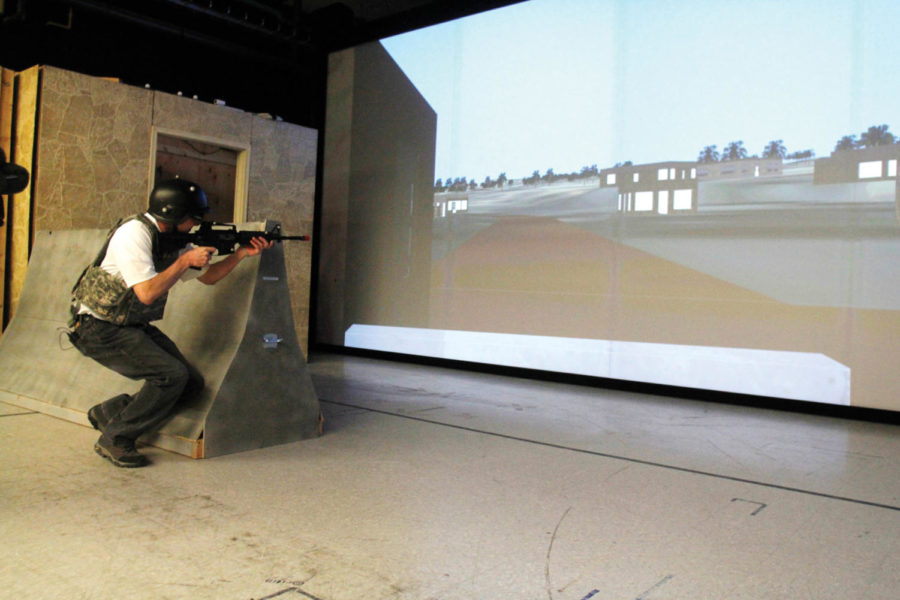MIRAGE virtual system gets whole body involved in lab
February 27, 2013
The Mixed Reality Adaptive Generalizable Environment room, commonly known as the Mirage room, is essentially a research lab that gets the whole human body involved on a physical level, but is enhanced with virtual reality.
The Mirage room, which is located in Black Engineering Building, consists of a 41-foot-wide by 13-foot-high fixed screen that is run by six active-stereo projectors. There is a surround sound audio system, reconfigurable walls with props and a motion analysis tracking system.
“We wanted to create an environment for training that can be just as immersive as a real city or building but that has more flexibility like a videogame,” said Stephen Gilbert, one of the founders of Mirage.
The tracking system consists of red tracking cameras placed on the ceiling that pick up the trackers on all the helmets, suits, guns and even the walls.
These tracking devices are highly reflective and allow for replay of all of the exact actions someone goes through. The trackers then forward the information to the computer, allowing someone to look at what things went right and what went wrong.
The trackers are also simulated to the computer, so if a wall moves, the wall is moved on the screen as well. The same goes for the people training and wearing the gear with sensors — when they move in real time, they are moving on the computer as well.
The computer then gets the exact orientation and position of something or someone.
Gilbert said a lot of aspects, such as dark hallways and physical structures, make the training more real and visceral than sitting in front of a screen interacting with a video game. He also said the use of digital technology, such as screens, combined with physical walls and rooms, allows for more flexibility and an endless amount of scenarios to run.
Gilbert also explained how important the guns were in this process and how accuracy has a role in all of it. The guns are airsoft guns that don’t actually shoot.
“We’ve built custom boards, so when the trigger is pulled, the info is sent to our computer to see exactly where it hit and the angle of the shot. It’s a little like laser tag on steroids,” Gilbert said.
Eliot Winer, one of the founders of Mirage, explained this room was originally developed for Army training.
Other options of training the Army may go through currently happen at places called mout sites.
Mout sites are artificial towns and villages set up to provide a lifelike experience. As many as 1,000 or more actors may be hired and put into costume to act as the enemy or soldiers to make the scene for the soldiers-in-training feel real.
This approach is effective, but Winer said there are downfalls.
“They’re lucky if they can run it once or twice a day due to the amount of time it takes to set up and get everyone into costume and action,” Winer said, “We can run different scenarios dozens, maybe even hundreds of times a day.”
He said it only takes approximately 20 minutes to change scenes, making the number of times they can run a scenario and the number of different scenarios they can choose from much larger than that of the mout sites.
“I really like taking all of these different pieces and all of the hardware and making it into something so that other people can use it,” said Ken Kopecky, a student working towards his doctorate in human computer interaction, and part of the Mirage team.
Recently, the Mirage team ran a study with some soldiers in the Mirage room to establish facets which could be improved. The input they received from the soldiers was to obtain better sound.
Gilbert and Winer explained that having speakers around the edge created sufficient sound, but having spatial sound would be preferred.
Wearing a headset that controls the sound so it seems to be coming from a specific place is an example of spatial sound. This makes the sounds in the scenario more controlled and realistic.
Though the Mirage room was created initially for training and research, it’s used for other things as well.
Winer described this room as “a Swiss army knife.”
He said anytime someone needs a large visualization, large area tracking or anything of that sort, this room is the place to go, which makes it quite convenient and helpful for Iowa State’s colleges.
Gilbert explained they are able to set up a system to measure heart rate, blood pressure and stress, transforming it into a place for firefighters to train.
“I want to make sure that if you, as a firefighter, go through a stressful scene, that I take you through that scene again and again until [it] does not make you stressed,” Gilbert said. “This allows you to be prepared and not stressed in a real-life situation.”
The Mirage team said they had to overcome a lot of obstacles in the creation of the room and continue to face difficulties in the progress of making the room even better.
“It’s fun because it’s a challenge. There are few people that have a three- to four-million-dollar system like this … to play around with and try to make it all work together,” said Joe Holub, a student working toward his doctorate in human computer interaction, computer engineering, and part of the Mirage team.
Gilbert and Winer said the basic goal is not to get many people in the Mirage room to train. Their primary goal is to use it as a research lab to discover how to make training elsewhere better and more accessible.







